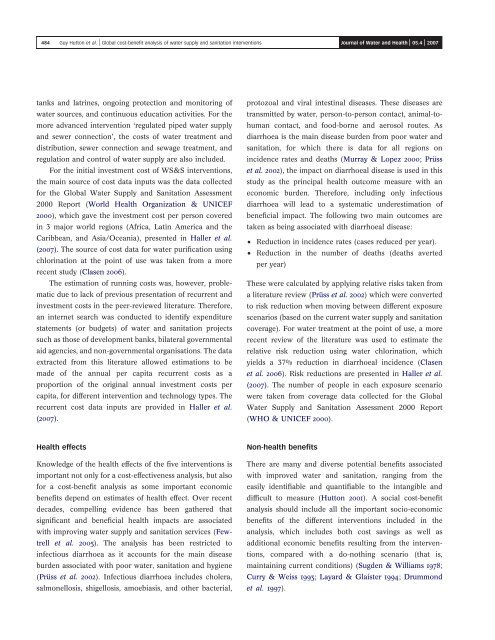Global cost-benefit analysis of water supply and sanitation ... - SuSanA
Global cost-benefit analysis of water supply and sanitation ... - SuSanA
Global cost-benefit analysis of water supply and sanitation ... - SuSanA
You also want an ePaper? Increase the reach of your titles
YUMPU automatically turns print PDFs into web optimized ePapers that Google loves.
484 Guy Hutton et al. | <strong>Global</strong> <strong>cost</strong>-<strong>benefit</strong> <strong>analysis</strong> <strong>of</strong> <strong>water</strong> <strong>supply</strong> <strong>and</strong> <strong>sanitation</strong> interventions Journal <strong>of</strong> Water <strong>and</strong> Health | 05.4 | 2007<br />
tanks <strong>and</strong> latrines, ongoing protection <strong>and</strong> monitoring <strong>of</strong><br />
<strong>water</strong> sources, <strong>and</strong> continuous education activities. For the<br />
more advanced intervention ‘regulated piped <strong>water</strong> <strong>supply</strong><br />
<strong>and</strong> sewer connection’, the <strong>cost</strong>s <strong>of</strong> <strong>water</strong> treatment <strong>and</strong><br />
distribution, sewer connection <strong>and</strong> sewage treatment, <strong>and</strong><br />
regulation <strong>and</strong> control <strong>of</strong> <strong>water</strong> <strong>supply</strong> are also included.<br />
For the initial investment <strong>cost</strong> <strong>of</strong> WS&S interventions,<br />
the main source <strong>of</strong> <strong>cost</strong> data inputs was the data collected<br />
for the <strong>Global</strong> Water Supply <strong>and</strong> Sanitation Assessment<br />
2000 Report (World Health Organization & UNICEF<br />
2000), which gave the investment <strong>cost</strong> per person covered<br />
in 3 major world regions (Africa, Latin America <strong>and</strong> the<br />
Caribbean, <strong>and</strong> Asia/Oceania), presented in Haller et al.<br />
(2007). The source <strong>of</strong> <strong>cost</strong> data for <strong>water</strong> purification using<br />
chlorination at the point <strong>of</strong> use was taken from a more<br />
recent study (Clasen 2006).<br />
The estimation <strong>of</strong> running <strong>cost</strong>s was, however, problematic<br />
due to lack <strong>of</strong> previous presentation <strong>of</strong> recurrent <strong>and</strong><br />
investment <strong>cost</strong>s in the peer-reviewed literature. Therefore,<br />
an internet search was conducted to identify expenditure<br />
statements (or budgets) <strong>of</strong> <strong>water</strong> <strong>and</strong> <strong>sanitation</strong> projects<br />
such as those <strong>of</strong> development banks, bilateral governmental<br />
aid agencies, <strong>and</strong> non-governmental organisations. The data<br />
extracted from this literature allowed estimations to be<br />
made <strong>of</strong> the annual per capita recurrent <strong>cost</strong>s as a<br />
proportion <strong>of</strong> the original annual investment <strong>cost</strong>s per<br />
capita, for different intervention <strong>and</strong> technology types. The<br />
recurrent <strong>cost</strong> data inputs are provided in Haller et al.<br />
(2007).<br />
protozoal <strong>and</strong> viral intestinal diseases. These diseases are<br />
transmitted by <strong>water</strong>, person-to-person contact, animal-tohuman<br />
contact, <strong>and</strong> food-borne <strong>and</strong> aerosol routes. As<br />
diarrhoea is the main disease burden from poor <strong>water</strong> <strong>and</strong><br />
<strong>sanitation</strong>, for which there is data for all regions on<br />
incidence rates <strong>and</strong> deaths (Murray & Lopez 2000; Prüss<br />
et al. 2002), the impact on diarrhoeal disease is used in this<br />
study as the principal health outcome measure with an<br />
economic burden. Therefore, including only infectious<br />
diarrhoea will lead to a systematic underestimation <strong>of</strong><br />
beneficial impact. The following two main outcomes are<br />
taken as being associated with diarrhoeal disease:<br />
† Reduction in incidence rates (cases reduced per year).<br />
† Reduction in the number <strong>of</strong> deaths (deaths averted<br />
per year)<br />
These were calculated by applying relative risks taken from<br />
a literature review (Prüss et al. 2002) which were converted<br />
to risk reduction when moving between different exposure<br />
scenarios (based on the current <strong>water</strong> <strong>supply</strong> <strong>and</strong> <strong>sanitation</strong><br />
coverage). For <strong>water</strong> treatment at the point <strong>of</strong> use, a more<br />
recent review <strong>of</strong> the literature was used to estimate the<br />
relative risk reduction using <strong>water</strong> chlorination, which<br />
yields a 37% reduction in diarrhoeal incidence (Clasen<br />
et al. 2006). Risk reductions are presented in Haller et al.<br />
(2007). The number <strong>of</strong> people in each exposure scenario<br />
were taken from coverage data collected for the <strong>Global</strong><br />
Water Supply <strong>and</strong> Sanitation Assessment 2000 Report<br />
(WHO & UNICEF 2000).<br />
Health effects<br />
Knowledge <strong>of</strong> the health effects <strong>of</strong> the five interventions is<br />
important not only for a <strong>cost</strong>-effectiveness <strong>analysis</strong>, but also<br />
for a <strong>cost</strong>-<strong>benefit</strong> <strong>analysis</strong> as some important economic<br />
<strong>benefit</strong>s depend on estimates <strong>of</strong> health effect. Over recent<br />
decades, compelling evidence has been gathered that<br />
significant <strong>and</strong> beneficial health impacts are associated<br />
with improving <strong>water</strong> <strong>supply</strong> <strong>and</strong> <strong>sanitation</strong> services (Fewtrell<br />
et al. 2005). The <strong>analysis</strong> has been restricted to<br />
infectious diarrhoea as it accounts for the main disease<br />
burden associated with poor <strong>water</strong>, <strong>sanitation</strong> <strong>and</strong> hygiene<br />
(Prüss et al. 2002). Infectious diarrhoea includes cholera,<br />
salmonellosis, shigellosis, amoebiasis, <strong>and</strong> other bacterial,<br />
Non-health <strong>benefit</strong>s<br />
There are many <strong>and</strong> diverse potential <strong>benefit</strong>s associated<br />
with improved <strong>water</strong> <strong>and</strong> <strong>sanitation</strong>, ranging from the<br />
easily identifiable <strong>and</strong> quantifiable to the intangible <strong>and</strong><br />
difficult to measure (Hutton 2001). A social <strong>cost</strong>-<strong>benefit</strong><br />
<strong>analysis</strong> should include all the important socio-economic<br />
<strong>benefit</strong>s <strong>of</strong> the different interventions included in the<br />
<strong>analysis</strong>, which includes both <strong>cost</strong> savings as well as<br />
additional economic <strong>benefit</strong>s resulting from the interventions,<br />
compared with a do-nothing scenario (that is,<br />
maintaining current conditions) (Sugden & Williams 1978;<br />
Curry & Weiss 1993; Layard & Glaister 1994; Drummond<br />
et al. 1997).
















